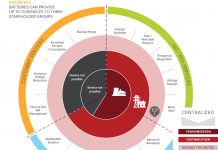In connection with this week’s launch of their new “What Matters” website McKinsey & Company published a pair of essays that should be of particular interest to alternative energy investors. The first essay, “Electron-Democracy,” describes the coming smart grid as a system that will be built outward from a core of centralized power plants, but increasingly be supported and stabilized by incremental energy flows between small producers and consumers that can respond nimbly to market demand with lower capital costs and more robust protection against disruption. Putting the pieces together, the authors suggest that:
“. . . the distributed grid might look like this: intermittent wind and solar power generation would be complemented by load-supplementing fuel cell plants, in much the same way that peak power and base load power plants interact today. Electric vehicles (EVs), plug-in hybrid electric vehicles (PHEVs), and batteries would serve as grid energy storage when excess energy is being produced.”
This outlook, which is rapidly building consensus, is a fundamental force that will drive investments in alternative energy for decades to come. In fact, it’s the raison d’être for wide swaths of the alternative energy industry.
The second essay, “Time to fix the wiring,” is a far more important contribution from Dr. Steven Chu, the new Secretary of Energy. This essay is remarkable because it presents a frank, readable and easily understood summary of the economic and technological factors that will drive the smart grid’s development. It is also an extraordinary public vision statement from Secretary Chu that neither equivocates nor obfuscates. It may be attributable to age or a misspent youth, but I can’t remember the last time a Cabinet Member spoke his mind and explained his vision with a comparable level of unambiguous clarity.
In framing the issue, Secretary Chu wrote:
“It’s important to understand where we are now. Existing energy technologies won’t provide the scale or cost efficiency required to meet the world’s energy and climate challenges. Corn ethanol is not a sustainable or scalable solution. Solar energy generated from existing technologies remains much more expensive than energy from fossil fuels. While wind energy is becoming economically competitive and could account for 10 to 15 percent of the electricity generated in the United States by the year 2030 (up from less than 1 percent now, according to the US Energy Information Administration), it is an intermittent energy source. Better long-distance electricity transmission systems and cost-effective energy storage methods are needed before we can rely on such a source to supply roughly 25 percent or more of base-load electricity generation (the minimum amount of electrical power that must be made available). Geothermal energy, however, can be produced on demand. A recent Massachusetts Institute of Technology (MIT) report suggests that with the right R&D investments, it could supply 10 percent of US power needs by 2050 (up from about 0.5 percent now).”
Since I’ve taken more than my share of criticism over the last eight months for insisting that energy storage must be cost-effective, I was delighted to see Secretary Chu take a position that it’s all about price vs. performance.
Last November I wrote “Alternative Energy Storage: Cheap Will Beat Cool,” a Seeking Alpha article that basically said economic decisions by users of energy storage systems would ultimately favor cost-effective technology over best available technology. I then demonstrated that within the energy storage sector, the companies that made “cool” energy storage devices carried disproportionately high market valuations compared to companies that made “cheap” energy storage devices. In light of Secretary Chu’s use of the term “cost-effective” to modify “energy storage” I think it will be worthwhile to revisit those issues in greater depth.
This morning I downloaded summary information on the Ardour Global Alternative Energy Index (^AGIGL) and eliminated any companies that were not based in the U.S. I then went to Yahoo! Finance and downloaded market capitalization, price to sales and price to book value data for all of the U.S.-based companies. After eliminating six energy storage stocks, the 45 remaining U.S.-based alternative energy companies had a combined book value of $15.5 billion, combined sales of $16.2 billion and a combined market capitalization of $27.2 billion, which works out to an average of 1.75 times book value and 1.68 times sales.
As long-term readers know, I track a small group of pure-play US-based energy storage companies and take a very egalitarian approach. My only qualifying question is “does the company manufacture rechargeable batteries or other devices that store electricity for future use?” Collectively, the twelve US-based energy storage companies that I track have $1.5 billion in equity and $6.7 billion in sales, but carry a combined market capitalization of $1.7 billion, which works out to an average of 1.13 times book value and 0.25 times sales. So from a sector perspective, my energy storage group trades at a hefty discount to the industry averages implied by the Ardour Index.
Any time a sector like energy storage trades at a steep discount to a broader average like the Ardour Index, I start thinking about bargain hunting opportunities because experience has taught me that market valuation metrics within an industry will tend to coalesce over time. The following tables segregate the energy storage companies I track into two basic classes, “cool technologies” and “cheap technologies.” For purposes of distinguishing between the two classes, I arbitrarily picked a product price point of $500 per kWh of energy storage capacity.
Collectively, the six cool technology companies have $217 million in book value and $372 million in sales, but they carry a combined market capitalization of $861 million, which works out to an average of 4.0 times book value and 2.3 times sales. These numbers are much higher than average price to book value and price to sales ratios for alternative energy stocks included in the broader Ardour Index. Accordingly, it seems reas
onable to suggest that the cool technology stocks are overvalued when compared to the rest of the alternative energy universe.
In comparison, the six cheap technology companies have $1.3 billion in book value and $6.3 billion in sales, but they only carry a combined market capitalization of $805 million, which works out to an average of 0.6 times book value and 0.1 times sales. These numbers are much lower than average price to book value and price to sales ratios for alternative energy stocks included in the broader Ardour Index. Therefore it seems reasonable to suggest that the cheap technology stocks are undervalued when compared to the rest of the alternative energy universe.
It strikes me as illogical that companies that focus on time-proven energy storage technologies trade at a significant discount to the Ardour Index averages while companies that focus on less reliable and more expensive technologies trade at a significant premium. It gets even odder when you consider that the bulk of the $2 billion in battery manufacturing subsidies in The American Recovery and Reinvestment Act of 2009 are supposed to be used for cost-effective technologies. This is more than a simple index problem. In fact, it appears to be a fundamental disconnect between sector valuations. Alternative energy and emerging storage technologies may be well respected, but nobody gives a second thought to the core group of cost-effective enabling technologies that will ultimately make alternative energy economically viable. I can’t justify the phenomenon, but it’s clear that cost-effective energy storage has become the orphan stepchild of the alternative energy industry. When faced with a market disconnect of this magnitude, I think alternative energy investors would be wise to remember the words of Benjamin Graham who said, “In the short run, the market acts like a voting machine, but in the long run it acts like a weighing machine.”
Disclosure: Author holds a large long position in Axion Power International (AXPW.OB) and small long positions in Active Power (ACPW), Exide (XIDE), Enersys (ENS) and ZBB Energy (ZBB).
John L. Petersen, Esq. is a U.S. lawyer based in Switzerland who works as a partner in the law firm of Fefer Petersen & Cie and represents North American, European and Asian clients, principally in the energy and alternative energy sectors. His international practice is limited to corporate securities and small company finance, where he focuses on guiding small growth-oriented companies through the corporate finance process, beginning with seed stage private placements, continuing through growth stage private financing and concluding with a reverse merger or public offering. Mr. Petersen is a 1979 graduate of the Notre Dame Law School and a 1976 graduate of Arizona State University. He was admitted to the Texas Bar Association in 1980 and licensed to practice as a CPA in 1981. From January 2004 through January 2008, he was securities counsel for and a director of Axion Power International, Inc. a small public company involved in advanced lead-acid battery research and development.








